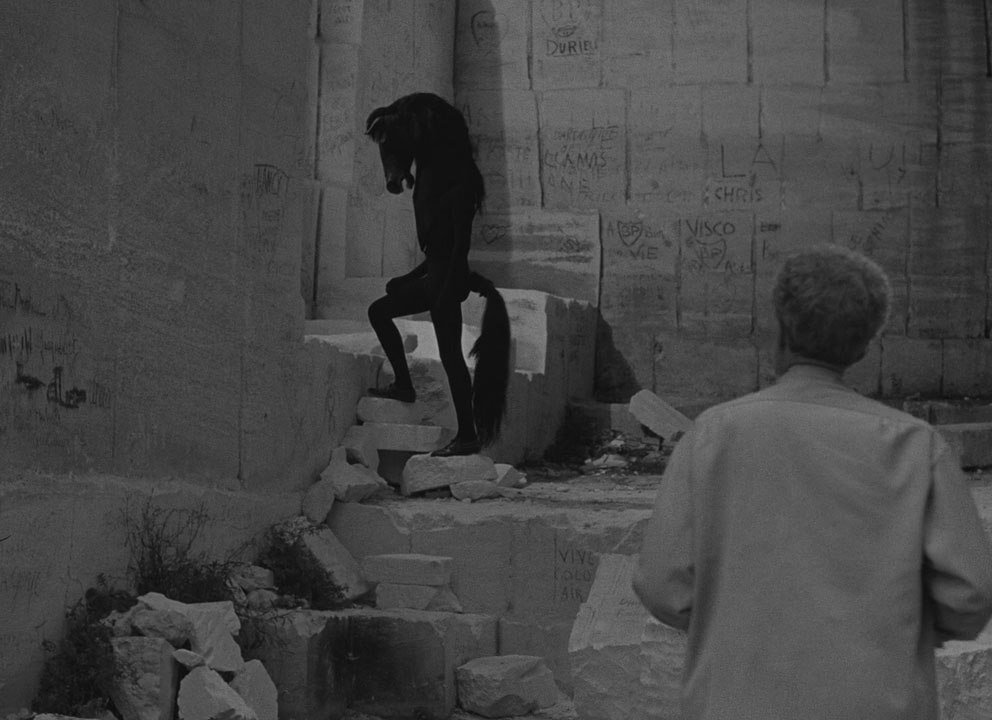Jacquot de Nantes (1991, Agnes Varda)
A pretty good movie about a kid growing up in small-town France wishing to make films – but if you’re a Varda/Demy fan who knows the backstory, that she’s filming her husband’s childhood memories as he’s dying, it becomes extremely wonderful and moving.
The Beaches of Jacques:

You see inspirations for The Umbrellas of Cherbourg, Donkey Skin, Pied Piper and Lola, family life, the love for music and cinema. Largely black and white with splashes of color. Varda flips between childhood events and the film they’d inspire, flashing a graphic of a pointing hand from the Demy Garage sign in between.
Jacquot 1:

“Seeing my name there when I was so young gave me a sense of the fragility of our existence.”

WWII occupies much of the film. His father helps with wartime manufacturing. The kids see Les Visiteurs du soir instead of Baron Munchausen because they’re not allowed see German films. In September 1943 his town is bombed. “There were dead all over town.” Adult Demy tells us he’s hated violence ever since.
Jacquot 2:

Making La Ballerine:

Young Demy spends a season with the clogmakers, works with puppet shows, decides he wants to manufacture theater and film sets. After tiring of the 8mm Chaplin film he’s given, he scrapes off the emulsion and hand-draws his own war story on the film. After a failed attempt at live-action shooting, he continues making films alone – stop-motion this time.
Jacquot 3:

Demy is sent to trade school but hates it, makes his stop-motion and keeps dreaming of cinema. The movie ends quite suddenly. “Later, Christian-Jaque came to Nantes to present his film D’homme a hommes. Christian-Jaque was kind enough to look at my film.” Demy gets to enroll in film school. “I met a woman filmmaker, we made a few films, then she gave me a fine son, and now I paint.”

L’Univers de Jacques Demy (1995, Agnes Varda)
Varda’s doc about her late husband’s films, with some personal details and stories thrown in, and interviews with key participants. Varda says they didn’t work together until Jacquot de Nantes, “so I’ll be discreet in this documentary.”
Demy on the set of Lola:

Covering all his films, in no particular order: Lola (with Anouk Aimee, Marc Michel and Michel Legrand), Three Seats for the 26th (with Francoise Fabian), Donkey Skin (with footage of Jim Morrison visiting the set). “I wanted to recreate things that Marais did with Cocteau.”
A Slightly Pregnant Man, then flashback to the war, the nazi bombing of his hometown. “After something as horrible as that, you get the feeling nothing worse can ever happen. And that’s when you start creating a fantasy world.” A Room in Town with Michel Piccoli. La Table tournante, codirected with animator Paul Grimault at the end of both men’s careers. A hilarious montage of scenes from 1954’s The Rebels of Lomanach in which Demy plays the soldier who dies first in every battle scene, then assisting Jean Masson and Georges Rouquier, who encouraged Demy by producing his clogmaker short.
Umbrellas of Cherbourg with Deneuve and producer Mag Bodard. Model Shop, which was “Lola in L.A.” and would have starred Harrison Ford if the studio hadn’t insisted on bankable star Gary Lockwood (heh). Varda catches up with Ford and asks Aimee about the sequel. Demy: “I called it Model Flop, which it was.” On to Pied Piper (also in English), The Seven Capital Sins (Demy drew Lust), and his weird-looking 1980’s Orpheus story Parking, “a fairy tale where there’s no fairy.” Back to Bay of Angels, then Lady Oscar and the TV movie La Naissance du jour (“I like it because I thought it was unfilmable”) before ending on a high note with Young Girls of Rochefort.


So, having just heard about them for the first time, I watched some of Demy’s early shorts.
Le Sabotier du Val de Loire (1956)
A solemn documentary about the clogmakers of Demy’s youth – or perhaps a half-documentary with a dramatic story added, including a death and a climactic wheelbarrow purchase.

Le Bel indifferent (1957)
Demy’s first non-hand-drawn color work, based on a Cocteau play about a very desperate and lonely woman, waiting all day for her man to return, but seeming even more alone when he does. Cinematography by Franju regular Marcel Fradetal.
Lead Actress Jeanne Allard appeared in Varda’s Les Creatures.

Ars (1959)
Another black-and-white semi-doc, this time about Jean-Marie Vianney, parish priest of the small town of Ars, who’d be named a saint after his death. Demy films museums and artifacts while briefly telling Vianney’s story, but most effectively he shoots the present-day town as if the events were happening currently.

Also watched Les Horizons Morts (1951) again – a very accomplished student film.
And happily, Demy’s homemade animations are available to watch in full, apart from their appearances in the above two features.
Le Pont de mauves (1944)
Bombing of the bridge.

Attaque Nocturne (1948)
Looks like the mugger is walking past the Demy Garage entrance.

La Ballerine (unknown date)
I love the pinholes tracing her path.


























































